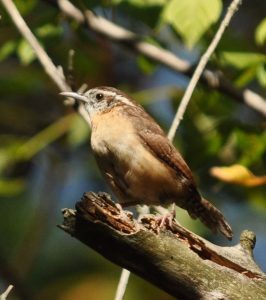Not only tropical birds duet with their mate, if you listen closely you can hear some of our local birds duetting, too. Or at least you may notice that female songbirds are not as silent as we often assume. Carolina Wrens Thryothorus ludovicianus and Northern Cardinals Cardinalis cardinalis are two species in which the female often joins her mate’s songs.
Listen to this excerpt of many hours of recordings of one pair of Carolina Wrens captured by Barbara Simpson in the North Carolina Botanical Garden, Chapel Hill on November 3, 1981 (BLB43057):
The female does not respond with the typical male-like “teakettle, teakettle, teakettle” song, but with a buzzy, rather high-pitched trill. The coordination is not as precise as in the neotropical wrens, rather in many cases the female overlaps the song of her mate. Still she communicates her presence on the territory to any listeners in the neighborhood, be it male or female Carolina Wrens.
Note the fainter song of another male Carolina Wren in-between the focal male’s songs.
Can you hear when the male switches to a different song type (not shown in spectrogram)?

Carolina Wrens “duetting”, the female chatter (red bar) overlaps the second song of the male (blue bar) and alternates with the third song
You may say that maybe a better example of a duetting species in our area is the Northern Cardinal.
In this common backyard species the female has a song as elaborate as that of her mate and she is often accompanied by her mate’s song. A female Northern Cardinal is easily distinguished from the male by her more subtle, brown plumage, allowing us to tell the sexes apart and notice whether a male or female is singing (In the monomorphic Carolina Wren we would have to color-mark the female to be sure that she does not also sing like her mate). Take a close look at the next Northern Cardinal that sings in your backyard, it may be a female. They are just as virtuous as the males of this species:

Male and female Northern Cardinal duetting; note song (an accelerating trill) of the Field Sparrow in-between
Familiarize yourself with the song of the female and male Northern Cardinal in the duet above.
Rich Bradley recorded this pair of Northern Cardinal at the Delaware Wildlife Area on April 13, 1994 (BLB41331).
I challenge you to get outside early one morning (Sunrise in the Columbus area is around 7:30am, so depending on cloud cover birds may start singing just after 7am). Listen to the dawn chorus of birds in your neighborhood, find your closest Northern Cardinal and listen to his song – or is it a female you are listening to? If you record the song on your phone, share the recording with us!
References:
All bird photos by Richard A Bradley – thank you Rich!
 About the Author: Angelika Nelson is the curator of the Borror Laboratory of Bioacoustics and instructor for the OSU Ohio Birds class each spring.
About the Author: Angelika Nelson is the curator of the Borror Laboratory of Bioacoustics and instructor for the OSU Ohio Birds class each spring.
*** We would like to hear from you – please leave a comment ***




Thanks for that quick tour of two of my favorite Ohio duetting species! For those who might want to learn more about the vocal interactions among Cardinal pairs, I suggest Don Kroodsma’s “The Singing Life of Birds” pages 357-365 (Houghton Mifflin Co. Boston, NY 2005). Don describes in detail a pre-dawn exchange between a pair of Northern Cardinals. You can also hear some nice recordings on the CD that comes with the book. Better still, follow Angelika’s advice and go outside and listen!
Rich, thank you for mentioning Don Kroodsma’s book, it is a great read indeed! just like his book Birdsong’s by the seasons in which he describes songs of different species from January through December – these two books are even available through the Columbus public library!
Introducing our YouTube Thumbnail Checker , designed for YouTube creators. Enhance your video thumbnails and titles effortlessly with this user-friendly, no-install online tool. Boost views by creating engaging thumbnails, comparing them to competitors, and optimizing with A/B testing. Elevate your YouTube success today!
Welcome to our Online Emoji Combination Generator! Instantly merge two emojis into a fantastic new combination with just one click. Best of all, it’s completely free, with over 30,000 unique mixes available. Try it now!